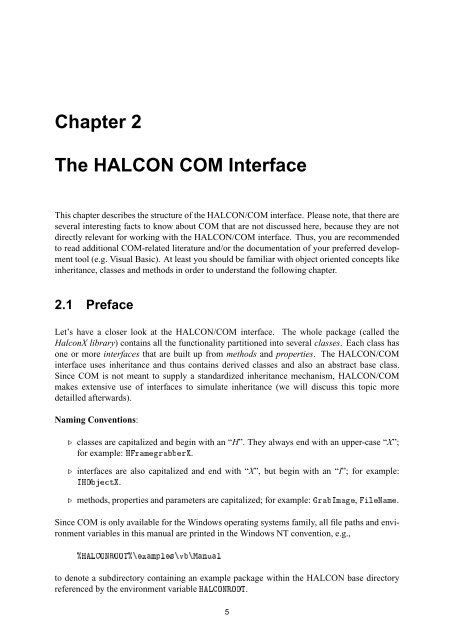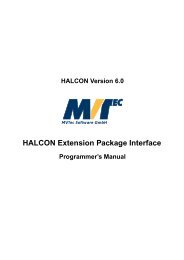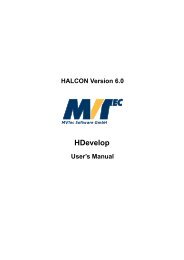HALCON/COM User's Manual
HALCON/COM User's Manual
HALCON/COM User's Manual
Create successful ePaper yourself
Turn your PDF publications into a flip-book with our unique Google optimized e-Paper software.
Chapter 2<br />
The <strong>HALCON</strong> <strong>COM</strong> Interface<br />
This chapter describes the structure of the <strong>HALCON</strong>/<strong>COM</strong> interface. Please note, that there are<br />
several interesting facts to know about <strong>COM</strong> that are not discussed here, because they are not<br />
directly relevant for working with the <strong>HALCON</strong>/<strong>COM</strong> interface. Thus, you are recommended<br />
to read additional <strong>COM</strong>-related literature and/or the documentation of your preferred development<br />
tool (e.g. Visual Basic). At least you should be familiar with object oriented concepts like<br />
inheritance, classes and methods in order to understand the following chapter.<br />
2.1 Preface<br />
Let’s have a closer look at the <strong>HALCON</strong>/<strong>COM</strong> interface. The whole package (called the<br />
HalconX library) contains all the functionality partitioned into several classes. Each class has<br />
one or more interfaces that are built up from methods and properties. The <strong>HALCON</strong>/<strong>COM</strong><br />
interface uses inheritance and thus contains derived classes and also an abstract base class.<br />
Since <strong>COM</strong> is not meant to supply a standardized inheritance mechanism, <strong>HALCON</strong>/<strong>COM</strong><br />
makes extensive use of interfaces to simulate inheritance (we will discuss this topic more<br />
detailled afterwards).<br />
Naming Conventions:<br />
º classes are capitalized and begin with an “H”. They always end with an upper-case “X”;<br />
for example: ÀÖÑÖÖ.<br />
º interfaces are also capitalized and end with “X”, but begin with an “I”; for example:<br />
ÁÀÇØ.<br />
º methods, properties and parameters are capitalized; for example: ÖÁÑ, ÐÆÑ.<br />
Since <strong>COM</strong> is only available for the Windows operating systems family, all file paths and environment<br />
variables in this manual are printed in the Windows NT convention, e.g.,<br />
±ÀÄÇÆÊÇÇ̱ÜÑÔÐ×ÚÅÒÙÐ<br />
to denote a subdirectory containing an example package within the <strong>HALCON</strong> base directory<br />
referenced by the environment variable ÀÄÇÆÊÇÇÌ.<br />
5
















